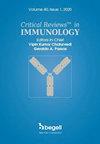Overexpression Of Homeobox A1 Relieves Ovalbumin-Induced Asthma In Mice By Inhibiting The Nf-Κb Signaling Pathway
IF 0.9
4区 医学
Q4 IMMUNOLOGY
引用次数: 0
Abstract
Objective. Homeobox A1 (HOXA1) is a protein coding gene involved in regulating immunity signaling. This study aims to explore the function and mechanism of HOXA1 in asthma. Methods. An asthma mouse model was established via ovalbumin (OVA) induction. Airway hyperresponsiveness was evaluated by the value of pause enhancement (Penh). Inflammatory cells in bronchoalveolar lavage fluid (BALF) were detected by Trypan blue and Wright staining. The pathological morphology of lung tissues was assessed by H&E staining. The IgE and inflammatory biomarkers (IL-1β, IL-6, IL-17, and TNF-α) in BALF and lung tissues were measured by ELISA. Western blot was performed to detect the expression of NF-κB pathway-related proteins. Results. HOXA1 was down-regulated in OVA-induced asthmatic mice. Overexpression of HOXA1 decreased Penh and relieved pathological injury of lung tissues in OVA-induced mice. Overexpression of HOXA1 also reduced the numbers of total cells, leukocytes, eosinophils, neutrophils, macrophages, and lymphocytes, as well as the levels of IgE, IL-1β, IL-6, IL-17, and TNF-α in BALF of OVA-induced mice. The inflammatory biomarkers were also decreased in lung tissues by HOXA1 overexpression. In addition, HOXA1 overexpression blocked the NF-κB signaling pathway in OVA-induced mice. Conclusion. Overexpression of HOXA1 relieved OVA-induced asthma in female mice by blocking the NF-κB signaling pathway.通过抑制 Nf-Κb 信号通路,过表达 Homeobox A1 可缓解卵清蛋白诱发的小鼠哮喘
目标。同源盒A1 (HOXA1)是一种参与调节免疫信号的蛋白质编码基因。本研究旨在探讨HOXA1在哮喘中的作用及机制。通过卵清蛋白(OVA)诱导建立哮喘小鼠模型。通过暂停增强值(Penh)评估气道高反应性。用台盼蓝和莱特染色检测支气管肺泡灌洗液(BALF)中的炎性细胞。H&E染色观察肺组织病理形态。采用ELISA法检测BALF和肺组织中IgE和炎症标志物(IL-1β、IL-6、IL-17、TNF-α)的变化。Western blot检测NF-κB通路相关蛋白的表达。在ova诱导的哮喘小鼠中,HOXA1表达下调。过表达HOXA1可减轻ova诱导小鼠肺组织的病理损伤。过表达HOXA1还能降低ova诱导小鼠BALF中总细胞、白细胞、嗜酸性粒细胞、中性粒细胞、巨噬细胞和淋巴细胞的数量,以及IgE、IL-1β、IL-6、IL-17和TNF-α的水平。肺组织中炎症标志物也因HOXA1过表达而降低。此外,在ova诱导小鼠中,HOXA1过表达可阻断NF-κB信号通路。过表达HOXA1通过阻断NF-κB信号通路缓解ova诱导的雌性小鼠哮喘。
本文章由计算机程序翻译,如有差异,请以英文原文为准。
求助全文
约1分钟内获得全文
求助全文
来源期刊
CiteScore
2.60
自引率
0.00%
发文量
14
审稿时长
>12 weeks
期刊介绍:
Immunology covers a broad spectrum of investigations at the genes, molecular, cellular, organ and system levels to reveal defense mechanisms against pathogens as well as protection against tumors and autoimmune diseases. The great advances in immunology in recent years make this field one of the most dynamic and rapidly growing in medical sciences. Critical ReviewsTM in Immunology (CRI) seeks to present a balanced overview of contemporary adaptive and innate immune responses related to autoimmunity, tumor, microbe, transplantation, neuroimmunology, immune regulation and immunotherapy from basic to translational aspects in health and disease. The articles that appear in CRI are mostly obtained by invitations to active investigators. But the journal will also consider proposals from the scientific community. Interested investigators should send their inquiries to the editor before submitting a manuscript.

 求助内容:
求助内容: 应助结果提醒方式:
应助结果提醒方式:


